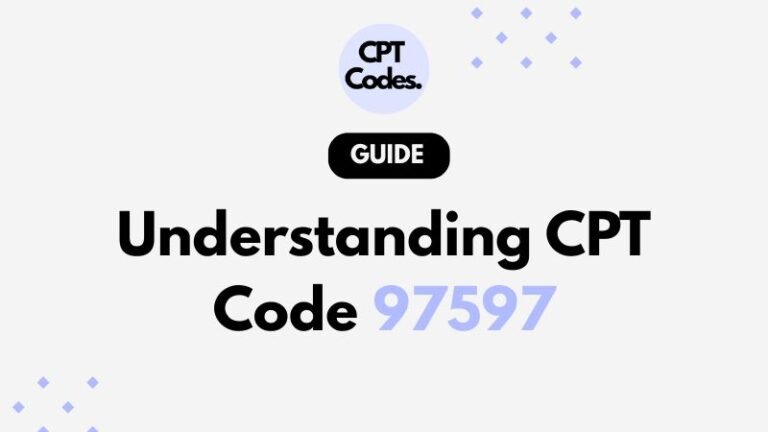In wound care and medical billing, CPT 97597 is a code every healthcare provider and medical coder should know. It specifically relates to active wound care and selective debridement, a procedure that plays an essential role in promoting healing and preventing infection.
This article breaks down what CPT 97597 covers, when it should be used, documentation requirements, billing rules, and common mistakes to avoid.
What Is CPT Code 97597?
-
Definition & Purpose
CPT 97597 is used to report selective debridement of open wounds. It involves the removal of devitalized tissue such as fibrin, exudate, debris, or biofilm, when the total wound surface area is 20 cm² or less. -
What It Includes
The service covers not only the debridement itself but also wound assessment, patient instructions, and dressing changes directly tied to that procedure. -
When To Use and When Not
Use CPT 97597 when medically necessary and when necrotic or non-viable tissue must be removed. Do not report it for simple wound cleaning if no necrotic tissue is present. If the procedure involves deeper tissues such as subcutaneous, muscle, or bone, surgical debridement codes (11042–11047) should be used instead.
CPT 97597 vs. Related Codes
| Code | Description | When to Use |
|---|---|---|
| CPT 97597 | Selective debridement, open wound, ≤ 20 cm² | For initial or small-area wound cleaning with necrotic tissue |
| CPT 97598 | Each additional 20 cm² (or part thereof) | When the wound area exceeds 20 cm² |
| CPT 97602 | Non-selective debridement | For non-selective wound cleaning procedures |
| CPT 11042–11047 | Surgical debridement (deeper layers) | For removal extending into subcutaneous tissue, muscle, or bone |
Documentation & Medical Necessity
Accurate documentation is essential for reimbursement and compliance. Records should include:
-
Wound description – size, location, depth, type of necrotic tissue
-
Method used – sharp, irrigation, enzymatic, or mechanical debridement
-
Amount of tissue removed – clearly described in clinical terms
-
Reason for debridement – medical necessity such as infection control or wound bed preparation
-
Plan of care – follow-up treatments, education provided, and healing goals
If an evaluation and management (E/M) service is performed on the same day, it must be distinct from the debridement and properly documented to justify modifier –25.
Billing & Reimbursement Tips
- Aggregate wound size should be calculated by adding similar wounds treated in the same session.
- Modifiers may be required when performed by therapists, depending on payer rules.
- Dressings and irrigation performed as part of the debridement are included and not billed separately.
- Do not combine CPT 97597 with surgical debridement codes for the same wound in the same encounter.
- Always verify payer policies and local coverage determinations (LCDs), as requirements may differ.
Why CPT 97597 Matters
- Ensures accurate billing and compliance
- Promotes high-quality wound care through proper coding
- Reduces audit risks by aligning documentation with payer requirements
- Helps therapists, wound care clinics, and physicians get appropriate reimbursement
Common Mistakes to Avoid
- Billing for wound cleaning without necrotic tissue present
- Failing to document wound size and tissue type removed
- Forgetting to bill 97598 when area exceeds 20 cm²
- Double-billing dressings or irrigation
- Using both selective and surgical debridement codes for the same wound on the same day
Conclusion
CPT Code 97597 is a vital code in wound care billing. When applied correctly with proper documentation, it supports quality patient care, ensures accurate reimbursement, and minimizes compliance risks. For providers, coders, and clinics, mastering the correct use of CPT 97597 is essential for both clinical excellence and financial integrity.

